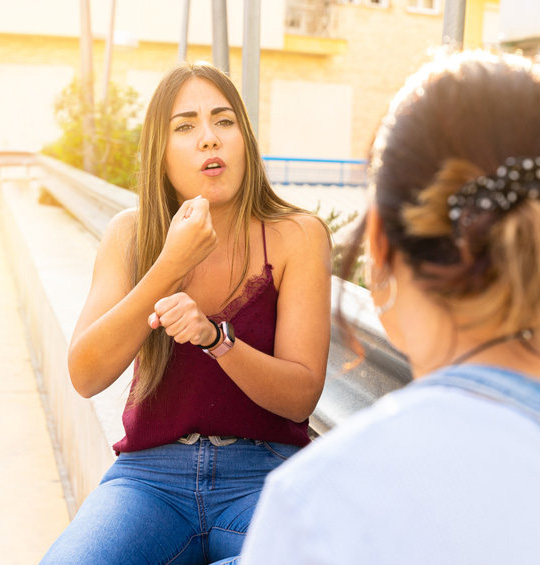Trying to read lips can be a lot of fun. Watching a baseball game and guessing what the manager is yelling at the umpire over a blown call can be as much fun as the actual game. It’s a useful tool in a lot of different ways.
Which group of people can do this best, though? Unlike what some people believe, deaf people aren’t born with the ability to read lips. But can they do it? And, should they?

The Challenges of Lip-Reading
When it comes to lip-reading, there are several levels to how people learn it. It’s probably the most difficult skill for someone who was born with total hearing loss. That’s because they might not be able to understand at first how people actually talk and what words sound like. This probably seems like a 10,000-piece jigsaw puzzle with all the pieces scattered. It usually takes them a while to learn.
Then there are those who have some hearing. They may have had progressive hearing loss or were born with hearing impairment. Since they have an idea of what other people sound like, they can learn to incorporate it into everyday conversation. As they get more comfortable, the people who have some hearing and use hearing aids, they may not be entirely conscious that they are lipreading. It’s all part of how they interact with people – they can hear some and lip read the rest to put the entire puzzle of the conversation together.
Like everything else in life, there are instances where lipreading works for people, and then there are times when they should think about other options to communicate with others.
Pros of Lip Reading
The main benefit of lip-reading is that it allows people who have complete or partial hearing loss to be able to communicate with others. While sign language can be useful, it can also isolate people who only use that. That’s because not everyone is going to want to learn a whole new language that also has its own way of constructing sentences.
Being able to look at someone and tell what they are saying can boost a deaf person’s confidence. They won’t feel like they are confined to just one group of people. When deaf people only sign, like at a school like Gallaudet University, it just makes it seem like an insular group that doesn’t want to communicate with all society.
Cons of Lip Reading
An acquaintance ran into one of the main problems of relying on lipreading when he lost all of his hearing after spending much of his life wearing a hearing aid. He’d been mainstreamed, so he’d never learned sign language. For the most part, he was able to get by reading people’s lips while he waited to be approved for a cochlear implant.
Then the worst happened. He lost his hearing in 2020 – which was around the time that everyone was wearing masks due to a certain pandemic. You probably see what’s coming – the masks blocked people’s mouths and they were often reluctant to lower the masks to talk. We’ll get to how he solved that in a bit.
Another con of lip-reading is that it pretty much works only in one-on-one situations. Crowds can be a nightmare, since unless you can get in front of each person, it’s a guessing game that even “gapping” can fail badly.
Accents can be very tricky since people can move their mouths differently when pronouncing a word as compared to what the person doing the lip reading is used to seeing.
Other Options
Fortunately, there are real-life solutions. Smartphones are very helpful when it comes to these situations where lip-reading may be hard, if not impossible. Let’s go back to that acquaintance we were talking about before:
They used a smartphone a couple of different ways to achieve the results that they wanted. The first solution was to activate the microphone and use the Notes app. The other person could talk, and then the app would transcribe what was being said. Even if there was a bit of mistranslation, it was fairly easy to get the gist of what was being said.
What if this was in a crowded or noisy situation? Then there was either the option of handing the phone back and forth with the other person typing what they wanted to say. People are used to texting all the time, anyway. Or they could just text back and forth from their phone, though it was a bit of an odd sight for others to see two people texting each other while being a few feet apart.
Myths and Misconceptions
When people think of lipreading, they have some preconceived notions that are wrong more often than not.
- Experienced Lip Readers Can Understand Everything Being Said: While people who have done this a long time can do better than novices, they can have trouble, too. That’s because people move their lips the same way for different words. As a result, they are basically understanding about 60% of what is being said. Just like in other scenarios, they have to mentally fill in the blanks to get the complete sentence. Context plays a big part.
- Lip Reading Is All Focused On Lips: It makes sense, doesn’t it, since it’s right there in the name. It’s far more than just looking at lips, though. They are looking at how the other person’s tongue and teeth are moving, so that they can piece together everything.
- It’s Easier to Understand Short Sentences: It’s easier to figure out what’s going on the longer that someone talks. There are more contextual clues. A terse statement can cause confusion.
- If The Other Person Talks Louder, It’s Easier to Lip Read: This is the same type of thinking as shouting at someone in a foreign country to help them understand English. The better thing to do is to have the other person whisper. This slows down their speech and makes it easier to lipread.
- It’s Something That Comes Naturally and Can’t Be Taught: Deaf babies don’t come out of the womb able to lip-read. It’s a skill that all people can learn. It takes a lot of time and practice. Technology has made it easier – there are websites and videos devoted to this. You can learn to use this, too.
Final Thought
Ultimately, lip-reading is a tool that can be used to help almost anyone communicate effectively. Deaf people should strongly consider learning it, and hearing people can also learn it to be able to talk both with other hearing people and deaf people. Then everyone can be happy.
Share this post with your friends using these one-click sharing options:
👉 Click here to share on Facebook.
👉 Click here to share on Twitter.
👉 Click here to share on LinkedIn.

Get the latest interviews, tips and guides in your inbox.